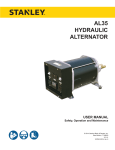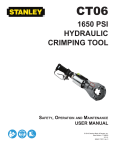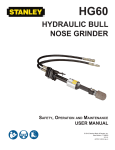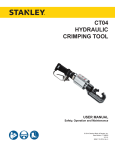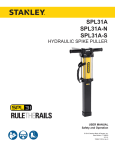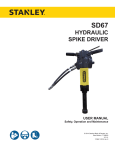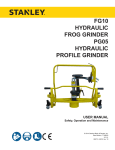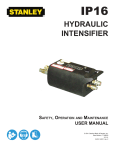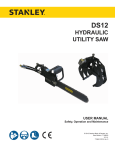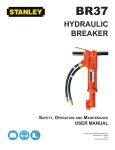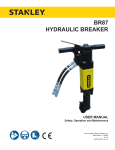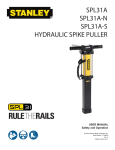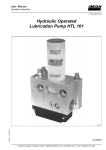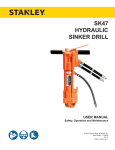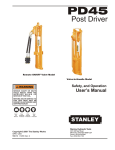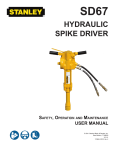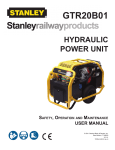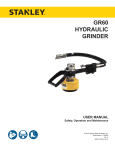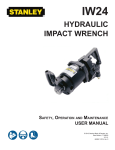Download HYDRAULIC ALTERNATOR - Truck Utilities Inc
Transcript
AL35 HYDRAULIC ALTERNATOR Safety, Operation and Maintenance USER MANUAL © 2010 Stanley Black & Decker, Inc. New Britain, CT 06053 U.S.A. 16798 2/2011 Ver. 4 TABLE OF CONTENTS SAFETY SYMBOLS...................................................................................................................................................4 SAFETY PRECAUTIONS...........................................................................................................................................5 TOOL STICKERS & TAGS.........................................................................................................................................7 HOSE TYPES.............................................................................................................................................................8 HOSE RECOMMENDATIONS...................................................................................................................................9 Figure 1. Typical Hose Connections........................................................................................................9 HTMA REQUIREMENTS..........................................................................................................................................10 OPERATION............................................................................................................................................................. 11 Figure 2. Diode Location.............................................................................................................................12 TOOL PROTECTION & CARE.................................................................................................................................13 TROUBLESHOOTING.............................................................................................................................................14 SPECIFICATIONS....................................................................................................................................................15 AL35 PARTS ILLUSTRATION..................................................................................................................................16 AL35 PARTS LIST....................................................................................................................................................17 AL35 MOTOR PARTS ILLUSTRATION....................................................................................................................18 AL35 WIRING DIAGRAM.........................................................................................................................................19 IMPORTANT To fill out a Product Warranty Recording form, and for information on your warranty, visit Stanleyhydraulic.com and select the Warranty tab. (Note: the warranty recording form must be submitted to validate the warranty). SERVICING THE STANLEY HYDRAULIC ALTERNATOR. This manual contains safety, operation, and routine maintenance instructions. Stanley Hydraulic Tools recommends that servicing of hydraulic tools, other than routine maintenance, must be performed by an authorized and certified dealer. Please read the following warning. WARNING SERIOUS INJURY OR DEATH COULD RESULT FROM THE IMPROPER REPAIR OR SERVICE OF THIS TOOL. REPAIRS AND / OR SERVICE TO THIS TOOL MUST ONLY BE DONE BY AN AUTHORIZED AND CERTIFIED DEALER. For the nearest authorized and certified dealer, call Stanley Hydraulic Tools at the number listed on the back of this manual and ask for a Customer Service Representative. AL35 User Manual ◄ 3 SAFETY SYMBOLS Safety symbols and signal words, as shown below, are used to emphasize all operator, maintenance and repair actions which, if not strictly followed, could result in a life-threatening situation, bodily injury or damage to equipment. This is the safety alert symbol. It is used to alert you to potential personal injury hazards. Obey all safety messages that follow this symbol to avoid possible injury or death. DANGER This safety alert and signal word indicate an imminently hazardous situation which, if not avoided, will result in death or serious injury. WARNING This safety alert and signal word indicate a potentially hazardous situation which, if not avoided, could result in death or serious injury. CAUTION This safety alert and signal word indicate a potentially hazardous situation which, if not avoided, could result in death or serious injury. CAUTION This signal word indicates a potentially hazardous situation which, if not avoided, may result in property damage. NOTICE This signal word indicates a situation which, if not avoided, will result in damage to the equipment. IMPORTANT This signal word indicates a situation which, if not avoided, may result in damage to the equipment. Always observe safety symbols. They are included for your safety and for the protection of the tool. LOCAL SAFETY REGULATIONS Enter any local safety regulations here. Keep these instructions in an area accessible to the operator and maintenance personnel. 4 ► AL35 User Manual SAFETY PRECAUTIONS Tool operators and maintenance personnel must always comply with the safety precautions given in this manual and on the stickers and tags attached to the tool and hose. • Always connect hoses to the alternator hose couplers before energizing the hydraulic power source. Be sure all hose connections are tight. • Do not operate the alternator at oil temperatures above 140 °F/60 °C. Operation at higher temperatures can cause higher than normal temperatures at the tool which can result in operator discomfort. Supervising personnel should develop additional precautions relating to the specific work area and local safety regulations. If so, place the added precautions in the space provided in this manual. • Never transport or carry the alternator with the unit energized and connected to electrical loads. • The AL35 Hydraulic Alternator will provide safe and dependable service if operated in accordance with the instructions given in this manual. Read and understand this manual and any stickers and tags attached to the tool and hoses before operation. Failure to do so could result in personal injury or equipment damage. Do not operate a damaged, improperly adjusted, or incompletely assembled alternator. • Observe local and national electrical codes for load wiring. To prevent electrical shock from faulty equipment, ground the alternator. If ground bonding is required, connect a length of heavy wire between the alternator ground terminal and the ground bond point. • Exercise reasonable caution to prevent electrical shock; do not operate the alternator with wet hands. • Do not operate the alternator in rain or snow. Do not let the alternator get thoroughly wet. • Do not connect the alternator to a building circuit. This could cause damage to the alternator or to electrical equipment in the building. These safety precautions are given for your safety. Review them carefully before operating the tool and before performing general maintenance or repairs. • Operator must start in a work area without bystanders. Keep bystanders clear of your work area. The operator must be familiar with the work area such as excessive slopes and dangerous terrain conditions. • Establish a training program for all operators to ensure safe operation. • Do not operate the alternator unless thoroughly trained or under the supervision of an instructor. • Always wear safety equipment such as goggles, ear and head protection, and safety shoes at all times when operating the alternator. • Never use tools near energized transmission lines. Know the location of buried or covered services before starting your work. • Do not overreach. Maintain proper footing and balance at all times. • Do not inspect or clean the alternator while the hydraulic power source is connected. Accidental engagement of the tool can cause serious injury. AL35 User Manual ◄ 5 SAFETY PRECAUTIONS • Do not start the alternator with electrical loads connected and in a power “ON” state. • Ensure that the alternator is at operating speed/voltage before connecting an electrical load. • Only use hydraulic hose labeled and certified as non‑conductive when using hydraulic tools on or near electrical lines. Failure to do so may result in death or serious injury. • Before using hose labeled and certified as non‑conductive, be sure the hose is maintained as nonconductive. The hose should be regularly tested for electric current leakage in accordance with your safety department instructions. • A hydraulic leak or burst may cause oil injection into the body or other severe personal injury. • Do not exceed specified flow and pressure for the alternator. Excess flow or pressure may cause a leak or burst. • Do not exceed the rated working pressure of hydraulic hose used with the alternator. Excess pressure may cause a leak or burst. • Check alternator hose couplers and connectors daily for leaks. Do not feel for leaks with your hands. Contact with a leak may result in severe personal injury. 6 ► AL35 User Manual • Do not lift or carry the alternator by the hoses. Do not abuse the hoses. Do not use kinked, torn or damaged hydraulic hose. • Make sure hydraulic hoses are properly connected to the alternator before pressuring the hydraulic system. The system pressure hose must always be connected to the alternator IN port. The system return hose must always be connected to the alternator OUT port. Reversing the connections may cause reverse tool operation which can result in severe personal injury. • Do not connect open‑center hydraulic tools to closed‑center hydraulic systems. This may result in loss of other hydraulic functions powered by the same system and/or may cause severe personal injury. The AL35 alternator is an open‑center hy‑ draulic tool. • To avoid personal injury or equipment damage all tool repair maintenance and service must only be performed by authorized and properly trained personnel. TOOL STICKERS & TAGS 12735 AL35 Name Tag 03763 GPM Sticker NOTE: THE INFORMATION LISTED ON THE STICKERS SHOWN, MUST BE LEGIBLE AT ALL TIMES. REPLACE DECALS IF THEY BECOME WORN OR DAMAGED. REPLACEMENTS ARE AVAILABLE FROM YOUR LOCAL STANLEY DISTRIBUTOR. The safety tag (p/n 15875) at right is attached to the tool when shipped from the factory. Read and understand the safety instructions listed on this tag before removal. We suggest you retain this tag and attach it to the tool when not in use. D A N G E R 1. FAILURE TO USE HYDRAULIC HOSE LABELED AND CERTIFIED AS NON-CONDUCTIVE WHEN USING HYDRAULIC TOOLS ON OR NEAR ELECTRICAL LINES MAY RESULT IN DEATH OR SERIOUS INJURY. BEFORE USING HOSE LABELED AND CERTIFIED AS NONCONDUCTIVE ON OR NEAR ELECTRIC LINES BE SURE THE HOSE IS MAINTAINED AS NON-CONDUCTIVE. THE HOSE SHOULD BE REGULARLY TESTED FOR ELECTRIC CURRENT LEAKAGE IN ACCORDANCE WITH YOUR SAFETY DEPARTMENT INSTRUCTIONS. 2. A HYDRAULIC LEAK OR BURST MAY CAUSE OIL INJECTION INTO THE BODY OR CAUSE OTHER SEVERE PERSONAL INJURY. A. DO NOT EXCEED SPECIFIED FLOW AND PRESSURE FOR THIS TOOL. EXCESS FLOW OR PRESSURE MAY CAUSE A LEAK OR BURST. B. DO NOT EXCEED RATED WORKING PRESSURE OF HYDRAULIC HOSE USED WITH THIS TOOL. EXCESS PRESSURE MAY CAUSE A LEAK OR BURST. C. CHECK TOOL HOSE COUPLERS AND CONNECTORS DAILY FOR LEAKS. DO NOT FEEL FOR LEAKS WITH YOUR HANDS. CONTACT WITH A LEAK MAY RESULT IN SEVERE PERSONAL INJURY. D A N G E R D. DO NOT LIFT OR CARRY TOOL BY THE HOSES. DO NOT ABUSE HOSE. DO NOT USE KINKED, TORN OR DAMAGED HOSE. 3. MAKE SURE HYDRAULIC HOSES ARE PROPERLY CONNECTED TO THE TOOL BEFORE PRESSURING SYSTEM. SYSTEM PRESSURE HOSE MUST ALWAYS BE CONNECTED TO TOOL “IN” PORT. SYSTEM RETURN HOSE MUST ALWAYS BE CONNECTED TO TOOL “OUT” PORT. REVERSING CONNECTIONS MAY CAUSE REVERSE TOOL OPERATION WHICH CAN RESULT IN SEVERE PERSONAL INJURY. 4. DO NOT CONNECT OPEN-CENTER TOOLS TO CLOSEDCENTER HYDRAULIC SYSTEMS. THIS MAY RESULT IN LOSS OF OTHER HYDRAULIC FUNCTIONS POWERED BY THE SAME SYSTEM AND/OR SEVERE PERSONAL INJURY. 5. BYSTANDERS MAY BE INJURED IN YOUR WORK AREA. KEEP BYSTANDERS CLEAR OF YOUR WORK AREA. 6. WEAR HEARING, EYE, FOOT, HAND AND HEAD PROTECTION. 7. TO AVOID PERSONAL INJURY OR EQUIPMENT DAMAGE, ALL TOOL REPAIR MAINTENANCE AND SERVICE MUST ONLY BE PERFORMED BY AUTHORIZED AND PROPERLY TRAINED PERSONNEL. I M P O R T A N T I M P O R T A N T READ OPERATION MANUAL AND SAFETY INSTRUCTIONS FOR THIS TOOL BEFORE USING IT. READ OPERATION MANUAL AND SAFETY INSTRUCTIONS FOR THIS TOOL BEFORE USING IT. USE ONLY PARTS AND REPAIR PROCEDURES APPROVED BY STANLEY AND DESCRIBED IN THE OPERATION MANUAL. USE ONLY PARTS AND REPAIR PROCEDURES APPROVED BY STANLEY AND DESCRIBED IN THE OPERATION MANUAL. TAG TO BE REMOVED ONLY BY TOOL OPERATOR. TAG TO BE REMOVED ONLY BY TOOL OPERATOR. SEE OTHER SIDE SEE OTHER SIDE SAFETY TAG P/N 15875 (Shown smaller then actual size) AL35 User Manual ◄ 7 HOSE TYPES The rated working pressure of the hydraulic hose must be equal to or higher than the relief valve setting on the hydraulic system. There are three types of hydraulic hose that meet this requirement and are authorized for use with Stanley Hydraulic Tools. They are: Certified non-conductive — constructed of thermoplastic or synthetic rubber inner tube, synthetic fiber braid reinforcement, and weather resistant thermoplastic or synthetic rubber cover. Hose labeled certified nonconductive is the only hose authorized for use near electrical conductors. Wire-braided (conductive) — constructed of synthetic rubber inner tube, single or double wire braid reinforcement, and weather resistant synthetic rubber cover. This hose is conductive and must never be used near electrical conductors. Fabric-braided (not certified or labeled non-conductive) — constructed of thermoplastic or synthetic rubber inner tube, synthetic fiber braid reinforcement, and weather resistant thermoplastic or synthetic rubber cover. This hose is not certified non-conductive and must never be used near electrical conductors. hOSE SAFETY TAGS To help ensure your safety, the following DANGER tags are attached to all hose purchased from Stanley Hydraulic Tools. DO NOT REMOVE THESE TAGS. If the information on a tag is illegible because of wear or damage, replace the tag immediately. A new tag may be obtained from your Stanley Distributor. D A N G E R D A N G E R 1. FAILURE TO USE HYDRAULIC HOSE LABELED AND CERTIFIED AS NON-CONDUCTIVE WHEN USING HYDRAULIC TOOLS ON OR NEAR ELECTRIC LINES MAY RESULT IN DEATH OR SERIOUS INJURY. FOR PROPER AND SAFE OPERATION MAKE SURE THAT YOU HAVE BEEN PROPERLY TRAINED IN CORRECT PROCEDURES REQUIRED FOR WORK ON OR AROUND ELECTRIC LINES. 2. BEFORE USING HYDRAULIC HOSE LABELED AND CERTIFIED AS NON-CONDUCTIVE ON OR NEAR ELECTRIC LINES. WIPE THE ENTIRE LENGTH OF THE HOSE AND FITTING WITH A CLEAN DRY ABSORBENT CLOTH TO REMOVE DIRT AND MOISTURE AND TEST HOSE FOR MAXIMUM ALLOWABLE CURRENT LEAKAGE IN ACCORDANCE WITH SAFETY DEPARTMENT INSTRUCTIONS. 3. DO NOT EXCEED HOSE WORKING PRESSURE OR ABUSE HOSE. IMPROPER USE OR HANDLING OF HOSE COULD RESULT IN BURST OR OTHER HOSE FAILURE. KEEP HOSE AS FAR AWAY AS POSSIBLE FROM BODY AND DO NOT PERMIT DIRECT CONTACT DURING USE. CONTACT AT THE BURST CAN CAUSE BODILY INJECTION AND SEVERE PERSONAL INJURY. 4. HANDLE AND ROUTE HOSE CAREFULLY TO AVOID KINKING, ABRASION, CUTTING, OR CONTACT WITH HIGH TEMPERATURE SURFACES. DO NOT USE IF KINKED. DO NOT USE HOSE TO PULL OR LIFT TOOLS, POWER UNITS, ETC. 5. CHECK ENTIRE HOSE FOR CUTS CRACKS LEAKS ABRASIONS, BULGES, OR DAMAGE TO COUPLINGS IF ANY OF THESE CONDITIONS EXIST, REPLACE THE HOSE IMMEDIATELY. NEVER USE TAPE OR ANY DEVICE TO ATTEMPT TO MEND THE HOSE. 6. AFTER EACH USE STORE IN A CLEAN DRY AREA. SEE OTHER SIDE SIDE 1 SEE OTHER SIDE (Shown smaller than actual size) DO NOT REMOVE THIS TAG DO NOT REMOVE THIS TAG The tag shown below is attached to “certified non-conductive” hose SIDE 2 D A N G E R D A N G E R 1. DO NOT USE THIS HYDRAULIC HOSE ON OR NEAR ELECTRIC LINES. THIS HOSE IS NOT LABELED OR CERTIFIED AS NON-CONDUCTIVE. USING THIS HOSE ON OR NEAR ELECTRICAL LINES MAY RESULT IN DEATH OR SERIOUS INJURY. 5. CHECK ENTIRE HOSE FOR CUTS CRACKS LEAKS ABRASIONS, BULGES, OR DAMAGE TO COUPLINGS IF ANY OF THESE CONDITIONS EXIST, REPLACE THE HOSE IMMEDIATELY. NEVER USE TAPE OR ANY DEVICE TO ATTEMPT TO MEND THE HOSE. 2. FOR PROPER AND SAFE OPERATION MAKE SURE THAT YOU HAVE BEEN PROPERLY TRAINED IN CORRECT PROCEDURES REQUIRED FOR WORK ON OR AROUND ELECTRIC LINES. 6. AFTER EACH USE STORE IN A CLEAN DRY AREA. 3. DO NOT EXCEED HOSE WORKING PRESSURE OR ABUSE HOSE. IMPROPER USE OR HANDLING OF HOSE COULD RESULT IN BURST OR OTHER HOSE FAILURE. KEEP HOSE AS FAR AWAY AS POSSIBLE FROM BODY AND DO NOT PERMIT DIRECT CONTACT DURING USE. CONTACT AT THE BURST CAN CAUSE BODILY INJECTION AND SEVERE PERSONAL INJURY. 4. HANDLE AND ROUTE HOSE CAREFULLY TO AVOID KINKING, CUTTING, OR CONTACT WITH HIGH TEMPERATURE SURFACES. DO NOT USE IF KINKED. DO NOT USE HOSE TO PULL OR LIFT TOOLS, POWER UNITS, ETC. SEE OTHER SIDE SEE OTHER SIDE SIDE 1 SIDE 2 (Shown smaller than actual size) 8 ► AL35 User Manual DO NOT REMOVE THIS TAG DO NOT REMOVE THIS TAG The tag shown below is attached to “conductive” hose. All hydraulic hose must meet or exceed specifications as set forth by SAE J517. All hydraulic hose must have at least a rated minimum working pressure equal to the maximum hydraulic system relief valve setting. This chart is intended to be used for hydraulic tool applications only based on Stanley Hydraulic Tools tool operating requirements and should not be used for any other applications. The chart to the right shows recommended minimum hose diameters for various hose lengths based on gallons per minute (gpm)/ liters per minute (lpm). These recommendations are intended to keep return line pressure (back pressure) to a minimum acceptable level to ensure maximum tool performance. Tool to Hydraulic Circuit Hose Recommendations 15-34 MM Inside Diameter INCH USE (Press/Return) PSI up to 10 up to 3 3/8 10 Both 2250 49-60 13-16 FLOW >>> RETURN <<< FLOW PRESSURE 26-100 up to 25 100-200 51-100 up to 50 100-300 51-100 up to 50 26-100 up to 25 8-30 up to 8 30-60 15-30 up to 15 30-90 15-30 up to 15 7.5-30 up to 7.5 Figure 1. Typical Hose Connections 49-60 13-16 38-49 10-13 38-49 19-40 5-10.5 10-13 19-40 5-10.5 38-49 19-40 5-10.5 10-13 15-23 15-23 4-6 3/8 10 19 19 25.4 3/4 1 16 5/8 3/4 19 25.4 1 19 3/4 3/4 16 16 19 5/8 16 5/8 3/4 5/8 16 13 13 5/8 1/2 1/2 Both Return Pressure Return Pressure Return Pressure Return Pressure Both Return Pressure Both Both Both 2500 2500 2500 2500 2500 2500 2500 2500 2500 2500 2500 2500 2500 2500 2500 175 175 175 175 175 175 175 175 175 175 175 175 175 175 175 155 BAR Min. Working Pressure Certified Non-Conductive Hose - Fiber Braid - for Utility Bucket Trucks METERS Hose Lengths FEET Conductive Hose - Wire Braid or Fiber Braid -DO NOT USE NEAR ELECTRICAL CONDUCTORS 4-6 4-9 LPM Oil Flow GPM HOSE RECOMMENDATIONS AL35 User Manual ◄ 9 HTMA REQUIREMENTS TOOL CATEGORY HYDRAULIC SYSTEM REQUIREMENTS TYPE I TYPE II TYPE III TYPE RR Flow Rate 4–6 gpm (15–23 lpm) 7–9 gpm (26–34 lpm) 11–13 gpm (42–49 lpm) 9–10.5 gpm (34–40 lpm) Tool Operating Pressure (At the power supply outlet) 2000 psi (145–155 bar) 2000 psi (138 bar) 2000 psi (138 bar) 2000 psi (138 bar) System relief valve setting (At the power supply outlet) 2100–2250 psi (145–155 bar) 2100–2250 psi (145–155 bar) 2100–2250 psi (145–155 bar) 2200–2300 psi (145–155 bar) Maximum back pressure (At tool end of the return hose) 250 psi (17 bar) 250 psi (17 bar) 250 psi (17 bar) 250 psi (17 bar) Measured at a max. fluid viscosity of: (At min. operating temperature) 400 ssu* (82 centistokes) 400 ssu* 400 ssu* 400 ssu* (82 centistokes) (82 centistokes) (82 centistokes) Temperature Sufficient heat rejection capacity to limit max. fluid temperature to: (At max. expected ambient temperature) 140 °F (60 °C) 140 °F (60 °C) 140 °F (60 °C) 140 °F (60 °C) Min. cooling capacity at a temperature difference of between ambient and fluid temps 3 hp (2.24 kW) 40 °F (22 °C) 5 hp (3.73 kW) 40 °F (22 °C) 7 hp (4.47 kW) 40 °F (22 °C) 6 hp (5.22 kW) 40 °F (22 °C) NOTE: Do not operate the tool at oil temperatures above 140 °F (60 °C). Operation at higher temperatures can cause operator discomfort at the tool. Filter Min. full-flow filtration Sized for flow of at least: (For cold temp. start-up and max. dirt-holding capacity) 25 microns 30 gpm (114 lpm) 25 microns 30 gpm (114 lpm) 25 microns 30 gpm (114 lpm) 25 microns 30 gpm (114 lpm) Hydraulic fluid 100–400 ssu* 100–400 ssu* 100–400 ssu* 100–400 ssu* Petroleum based (Premium grade, anti-wear, non-conductive) Viscosity (At min. and max. operating temps) (20–82 centistokes) NOTE: When choosing hydraulic fluid, the expected oil temperature extremes that will be experienced in service determine the most suitable temperature viscosity characteristics. Hydraulic fluids with a viscosity index over 140 will meet the requirements over a wide range of operating temperatures. *SSU = Saybolt Seconds Universal 10 ► AL35 User Manual OPERATION The recommended hose size is .500 inch/12 mm I.D. up to 50 ft/15 m long and .625 inch/16 mm I.D. minimum up to 100 ft/30 m. Operation Procedures 1. Observe all safety precautions. Pre-Operation Procedures CAUTION Electrical Ground If required, ground the electrical load and alternator at the ground lug on the alternator frame, lower right (as viewed from the front). Check Power Source 1. Using a calibrated flowmeter and pressure gauge, check that the hydraulic power source develops a flow of 7–9 gpm/26–34 lpm at 2000 psi/140 bar. 2. Make certain the hydraulic power source is equipped with a relief valve set to open at 2100 psi/145 bar maximum. Do not connect or otherwise apply power to an electrical load until the alternator has come up to speed. 2. Move the hydraulic circuit control to the “ON” position. As the alternator comes up to speed, a maximum electrical load of 3500 W, single‑phase 60 Hz alternating current, at 120 volts becomes available. 3. Connect the electrical loads. Connect Hoses 1. Wipe all hose couplers with a clean, lint-free cloth before making connections. 2. Connect the hoses from the hydraulic power source to the tool fittings or quick disconnects. It is a good practice to connect return hoses first and disconnect them last to minimize or avoid trapped pressure within the tool. 3. Observe flow indicators stamped on hose couplers to ensure that fluid flow is in the proper direction. The female coupler on the tool hose is the inlet coupler. 4. Move the hydraulic circuit control valve to the ON position to operate the tool. NOTE: If uncoupled hoses are left in the sun, pressure in‑ crease within the hoses may make them difficult to connect. When possible, connect the free ends of the hoses together. CAUTION Do not exceed the alternator’s rated 3500 W capacity. NOTE: Output voltage is proportional to the RPM of the hy‑ draulic motor. Flashing The Field This procedure establishes residual magnetism in the field windings, to provide start-up excitation and proper output voltage levels. 1. Stop the alternator. 2. Remove the receptacle panel. 3. Using a 12 volt automotive battery, touch the positive lead to the positive (+) diode set with the white or silver band, located on the rotor assembly. At the same time touch the negative lead to the negative (-) diode. Hold the leads against the diodes for 2-4 seconds. NOTE: Do not reverse the polarity of the leads. This may cause damage to the diodes or the rotor or both. 4. Replace the receptacle panel and start the alternator. AL35 User Manual ◄ 11 OPERATION PREVENTATIVE MAINTENANCE SCHEDULE In Dirty or Moist Environments 90 Day Intervals If the unit is operated or stored in a dirty, moist, or salt moisture environment, the electrical contacts, rotor and stator should be inspected and cleaned every 90 days or more frequently as deemed necessary. Positive and Negative Diodes In Clean, Dry Environments 12 Month Intervals If the unit is operated or stored in a clean and dry environment, the electrical contacts, rotor, and stator should be inspected and cleaned every 12 months or more frequently as deemed necessary. No other preventative maintenance is required. Cold Weather Operation If the breaker is to be used during cold weather, preheat the hydraulic fluid at low engine speed. When using the normally recommended fluid, fluid temperature should be at or above 50 °F/10 °C (400 ssu/82 centistokes) before use. Damage to the hydraulic system or breaker can result from use with fluid that is too viscous or thick. 12 ► AL35 User Manual Figure 2. Diode Location TOOL PROTECTION & CARE NOTICE In addition to the Safety Precautions found in this manual, observe the following for equipment protection and care. • Make sure all couplers are wiped clean before connection. • The hydraulic circuit control valve must be in the “OFF” position when coupling or uncoupling hydraulic tools. Failure to do so may result in damage to the quick couplers and cause overheating of the hydraulic system. • Always store the tool in a clean dry space, safe from damage or pilferage. • Make sure the circuit PRESSURE hose (with male quick disconnect) is connected to the “IN” port. The circuit RETURN hose (with female quick disconnect) is connected to the opposite port. Do not reverse circuit flow. This can cause damage to internal seals. • Always replace hoses, couplings and other parts with replacement parts recommended by Stanley Hydraulic Tools. Supply hoses must have a minimum working pressure rating of 2500 psi/172 bar. • Do not exceed the rated flow (see Specifications) in this manual for correct flow rate and model number. Rapid failure of the internal seals may result. • Always keep critical tool markings, such as warning stickers and tags legible. • Do not force a small breaker to do the job of a large breaker. • Keep tool bit sharp for maximum breaker performance. Make sure that tool bits are not chipped or rounded on the striking end. • Never operate a breaker without a tool bit or without holding it against the work surface. This puts excessive strain on the breaker foot. • Tool repair should be performed by experienced personnel only. • Make certain that the recommended relief valves are installed in the pressure side of the system. • Do not use the tool for applications for which it was not intended. AL35 User Manual ◄ 13 TROUBLESHOOTING PROBLEM Tool does not run. No electrical output. CAUSE REMEDY Power unit not functioning. Check power unit for power flow and pressure (7-9 gpm/26-34 lpm, 2000 psi/140 bar. Couplers or hoses blocked. Remove restriction. Hyrevz motor failure. Inspect and repair. Hydraulic lines not connected. Connect lines. Open circuit breaker. Reset circuit breaker. Faulty receptacle. Replace receptacle. Loose/broken wires. Locate and repair. Loss of residual magnetism. Flash and Field. Refer to section in this manual. Short circuit in rotor filed or diodes. Return to an authorized service center. Low output. Shorted AC or exciter stator windings. Check with Ohmmeter. Continuity should exist between black/white and red/red wires. No continuity from black/white to red wire or any wire to ground. If a short is found, replace the stator. Hyrevz motor speed too slow. Check for proper flow of 7-9 gpm/26-34 lpm. Unbalanced or excessive load. Balance load between circuits, load should not exceed rated capacity. High backpressure. Check for excessive backpressure, over 250 psi/17 bar. Couplers/hoses blocked. Locate and remove blockage. Oil too hot/cold. Above 150°F/66°C Check power source for proper oil or below 50°F/10°C. temperature. Bypass cooler to warm oil; or provide cooler to maintain proper temperature. Relief valve set too low. Adjust relief valve to 2000 psi/145 bar. Motor worn. Inspect; repair/replace. Output too high. Motor over-speeding. Check power unit for proper flow. 7-9 gpm/26-34 lpm. Alternator overheats. Overloaded. Reduce electrical load; load should not exceed rated capacity. Air intake plugged or covered. Clear air intake. Windings covered with dirt. Clean windings. 14 ► AL35 User Manual SPECIFICATIONS The AL35 is a hydraulic motor powered electrical alternator, designed to provide power for lights, small power tools, and small appliances. It produces 3500 watts of power at a nominal 120/240 volts AC single phase at 60 Hz frequency. The unit requires hydraulic power delivered at 7–9 gallons per minute (gpm) with pressure up to 2000 pounds per square inch (psi). Capacity.......................................................................................... 3500 W 120/240 V, 60 Hz at 8 gpm/30 Ipm Input Outlets .................................................................................................... 240 V/15 A, 120 V/20 A, 120 V/15 A Duplex Pressure Range ............................................................................................................................... 2000 psi/140 bar Flow Range..................................................................................................................................7–9 gpm/26–34 Ipm Optimum Flow .......................................................................................................................................8 gpm/30 Ipm Porting...................................................................................................................................................10 SAE O‑ring Connect Size and Type ...............................................................................................................1/2 NPT Pipe Fitting Weight .................................................................................................................................................... 70 Ib/31.8 kg Overall Length ................................................................................................................................19 inches/47.9 cm Width ................................................................................................................................................9 inches/22.7 cm Height .............................................................................................................................................10 inches/25.4 cm Motor .................................................................................................................................Stanley Hyrevz P/N 21446 AL35 User Manual ◄ 15 2 3 16 ► AL35 User Manual 1 2 3 4 August 1998 14 6 13 12 AL35 ALTERNATOR 7 8 9 5 21 15 26 22 30 16 17 18 28 22 21 10 31 19 20 36 35 23 25 43 37 27 24 32 38 40 41 20 22 21 39 42 AL35 PARTS ILLUSTRATION AL35 PARTS LIST Item Part No. Qty Description Item Part No. Qty 1 15100 1 Voltmeter 38 12622 1 Mounting Bracket—Tall 39 04353 4 Esna Nut Description 2 COM* 4 Phillips Head Machine Screw 3 COM* 4 Washer 40 21446 1 Hyrevz Motor Assembly 1 Receptacle Panel 41 03786 1 Sticker, GPM 42 00936 2 Adaptor 4 5 15101 1 Receptacle, 30 A, 120 V 6 15103 1 Receptacle, 15 A, 240 V 7 — — included with Item 1 8 15106 1 Circuit Breaker, 30 A 9 35235 1 Capacitor 10 05734 4 Capscrew, 3/8-16 × 2 Hex Head 11 — — No Item 12 15102 1 Receptacle, 15 A, 120 V 13 15105 1 Circuit Breaker, 15 A 14 12692 4 Stator Bolt 11" long 15 12735 1 Name tag 16 26604 1 Receptacle Box 17 COM* 1 Capscrew 18 COM* 1 Lockwasher 19 26607 1 Outboard Bearing Bracket Assy 20 05351 4 Foot 21 00429 6 Hex Nut 5/16-18 22 03031 6 Washer 5/16 23 12628 1 Mounting Bracket—short 24 21315 2 Capscrew, 5/16-18 × 1-1/4 25 00171 1 O-ring 26 35237 1 Stator Assy 27 12690 1 Capscrew 28 12691 1 "C" Washer 29 — — No Item 30 35236 1 Rotor Assembly 31 26606 1 Adapter, Inboard Engine End 32 12694 1 Grounding Lug 33 — — No Item 34 — — No Item 35 20051 4 Nut, Lockwasher 1/4-20 36 02688 2 Capscrew 5/16-18 × 3/4 37 05325 1 Motor Adaptor COM* indicates common parts available through local sources AL35 User Manual ◄ 17 AL35 MOTOR PARTS ILLUSTRATION AL35 Motor Assembly P/N 21446 1 2 3 4 5 6 7 10 8 11 4 12 13 14 9 15 16 17 Item Part No. Qty Description 1 00120 8 Capscrew, 1/4-20 × 2-1/4 HSH 2 07386 1 Gear Housing Assembly 3 00713 2 Dowel Pin 4 06316 4 Bushing 5 00178 1 O-ring * 6 06854 1 Idler Shaft 7 06853 1 Drive Gear 8 06855 1 Idler Gear 9 21432 Bearing Housing Assembly 10 00669 Quad Ring * 11 00171 O-ring * 12 19884 Seal Gland 13 00170 Retaining Ring 14 00708 Retaining Ring 15 00148 Bearing 16 06881 Needle Roller 17 06876 Drive Shaft 18 00166 Retaining Ring * Indicates part of Seal Kit 07388 18 ► AL35 User Manual 18 W SILVER 115V 30A NEMA L530R 14 AWG WHT 30A 14 AWG WHT X GOLD G SILVER GOLD 14 AWG BLK GOLD 15A GND GOLD 14 AWG BLK 1. RECEPTACLE TERMINALS ARE DRAWN AS SEEN FROM THE BACK. 14 AWG GRN 14 AWG BLK 14 AWG GRN 14 AWG BLK 14 AWG GRN 14 AWG BLK 14 AWG BLK(P) 1 14 AWG BLK(P) 2 14 AWG WHT(P) 3 14 AWG WHT(P) 4 14 AWG WHT(P) 5 14 AWG BLK(P) 6 14 AWG GRN 16 AWG RED 16 AWG RED 1 2 3 4 5 6 7 8 P1 CAPACITOR 14 AWG GRN(P) 8 9 J1 1 1 2 2 4 5 GND 6 TO FRAME 3 AL35 WIRING DIAGRAM Use clean solvent In well ventilated areas. Avoid prolonged Inhalation of vapors and prolonged or repeated contact with skin. Keep away from heat or open flame. AL35 User Manual ◄ 19 Stanley Hydraulic Tools 3810 SE Naef Road Milwaukie, Oregon 503-659-5660 / Fax 503-652-1780 www.stanleyhydraulic.com IMPORTANT To fill out a Product Warranty Recording form, and for information on your warranty, visit Stanleyhydraulic.com and select the Warranty tab. (Note: the warranty recording form must be submitted to validate the warranty).




















